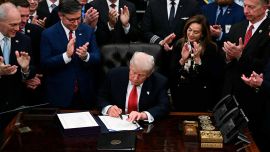If Albert Einstein is said to have defined insanity as repeating the same thing and expecting different results, San Luis contradicts that logic by standing out among inland provinces, despite taking their generally dinosaur politics to even greater extremes. As it happens, the man after whom this province is named – Saint Louis, who ruled France from 1226 to 1270, or San Luis Rey in Spanish – is a far earlier exception to Einstein’s dictum when compared to his English contemporary Henry III (reigned 1216-1272). Both monarchs were deeply religious yet Henry was a pious weakling whose long reign sunk into civil strife against Simon de Montfort but also kick-started parliamentary evolution, thus ensuring that his father King John Lackland’s famous Magna Carta was not a mere flash in the pan. In contrast, the strict impartiality of Louis IX’s judgements stemming from his saintly integrity made all France crave royal justice in a highly unjust world with the rapid spread of royal courts, thus cementing central power and national unity – a worldly success story due to not despite being a saint. In short, Henry III was a born loser and Louis IX a winner with identical philosophies of life.
The Rodríguez Saá brothers who have ruled this province for 30 of the last 36 years are no saints, of course (anybody with any doubts on that score might like to dig into the bizarre details of the-governor Adolfo Rodríguez Saá’s alleged kidnap together with his drugged education minister Natalia Spinuzza at the “Y No Sé” rent-by-thehour motel in 1993), but they have created a province which works at various levels – and not just Mussolini’s trains running on time. This columnist has stood at the Córdoba-San Luis border near Merlo and seen how the well-paved road which typifies this province becomes a dirt track on the other side (evidently Lázaro Báez never set foot here).
Hard to say how they did it. Few natural resources beyond some quartz quarries and the province is only sporadically arable even if its picturesque rolling hills make for some attractive tourist centres like Potrero de los Funes and Merlo. No fiscal abundance either (although last week’s Supreme Court ruling ordering the remittance of federal revenuesharing arrears to the tune of 15 billion pesos will undoubtedly help) – the provincial taxation in 15 of the 23 provinces represents a higher percentage of total revenue.
One key to success was making far more intensive use of the 1979-2012 industrial promotion scheme than the other three beneficiaries – so much so that around 80 percent of some 250 companies lured to the industrial park had outgrown their dependence on tax and import duty breaks by 2012. But perhaps the real secret of the Rodríguez Saás is their strict application of the Harry Truman “the buck stops here” principle when it comes to corruption – whereas the Lázaro Báez highways of other provincial strongmen are littered with the tolls mounted by their political aides, middlemen and an army of provincial employees, the Rodríguez Saás streamline their payroll (at 28 percent of the workforce, the lowest percentage in Argentina outside the big three of Buenos Aires, Córdoba and Santa Fe), placing all provincial funds at the disposal of their benevolent despotism.
Yet when Adolfo Rodríguez Saá surprisingly emerged as caretaker president in the last days of a chaotic 2001, the insanity of different results from the same methods was repeated – 18 years of tidy gubernatorial stewardship were followed by a truly disastrous week of national presidency when his rash default knocked Argentina off balance over the debt issue to this day, lurching from one extreme to the other.
Originally Comechingones territory, this province entered the Spanish orbit late in the 16th century when the city of San Luis was founded from Chile in 1596, remaining within the Mendoza-based Cuyo region throughout the colonial period. One of the 13 city halls creating the United Provinces of the River Plate in 1810, San Luis first became a full-fledged province in 1820.
Current Governor Adolfo Rodríguez Saá is far from being the first of that surname – there were three Saás (Juan, Felipe and Teófilo) in the second half of the 19th century, followed by three Rodríguez Saás in the first half of the 20th: Adolfo ‘El Pampa’ (1909-1913), Umberto (1922) and Ricardo (1934- 1938). El Pampa, who owed his personal fortune to his expertise in forging land deeds, gave the province running water and its first network of paved roads – evidently a style which runs in the family. Of the 110 governors and trustees between 1820 and 1976, Adolfo and Ricardo were two of just 11 who served out full four-year terms.
Far stabler since 1983 with just four governors, including the same surname in 30 of the 36 years as we have seen – the exceptions were the first woman María Alicia Lemme (2001-2003), the lieutenant-governor replacing Adolfo Rodríguez Saá when he became president, and Claudio Poggi (2011-15), once part of the machine and now President Mauricio Macri’s great white hope against the dynasty in the elections scheduled for June 16. One of the five provinces eternally Peronist since 1983, this did not prevent Adolfo from running his own presidential candidacy in 2003 and 2015, sweeping all three Cuyo provinces in his first bid.
The gubernatorial clash stands to be more interesting than the Congress voting. The three senators (Peronists Adolfo Rodríguez Saá, one of three ex-presidents in the Upper House, and María Eugenia Catalfamo opposed by Poggi elected on his breakaway Avanzar San Luis list) will not face renewal until 2023. Only two of the five deputies (Peronists Karim Alume Sbodio, Ivana Bianchi, Victoria Rosso and Andrés Vallone and Radical José Luis Riccardo) face the polls in October, namely Bianchi and Vallone, which seems certain to end in an even split although the dynastic machine has achieved clean sweeps in the past.
Of a population approaching half a million in nine departments (432,310 in the 2010 census), 377,673 were eligible to vote in 2017 – apart from the provincial capital, (169,947), Villa Mercedes (111,391, founded in 1706) is the other six-digit population and Merlo (17,087, all 2010 census data) the only five-digit population.
If Thornton Wilder’s The Bridge of San Luis Rey asks why God should choose the five victims of a collapsing bridge in colonial Peru to die, this San Luis evokes the question of how some provinces and nations do more with less and others less with more. Next Saturday we move from the San Luis of the Rodríguez Saás to the Neuquén of the Sapags on the eve of the latter’s elections.
#6 San Luis
Electorate (2017): 377,673
Governor: Alberto Rodríguez Saá (Peronist)
Deputies: Five (4 Peronists, 1 Radical)
Senators: (2 Peronist, 1 other)
On the ballot: Two of five deputies






















Comments